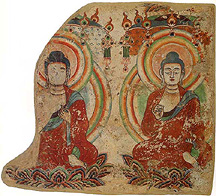
Found at the Cave 19, Bezeklik, near Turfan
Xinjiang Province, China
9th century CE
Mural, ink and mineral pigments
67 x 72 cm
Acquisition number: #MIK III 8382
Image courtesy of the Museum für Indische Kunst (copyright reserved)
Staatliche Museen zu Berlin - Preussischer Kulturbesitz
Cave 19 at Bezeklik consists of a barrel-vaulted, windowed porch in front, and a temple space carved out of rock in the rear. The primary image of worship was placed in the center of the temple on a pedestal. This mural fragment was removed from this pedestal. Distinctly East Asian in style, it is likely that the two figures were originally joined by a long line of other Buddhas, all painted in a virtually identical manner. The only significant difference between these two figures is found in their hand positions, known as mudra.
Rather than the fresco method commonly used in Europe, mural paintings such as this is achieved by applying ground mineral pigments suspended in a glue medium. The source of many of the minerals used in the cave temples of the Tarim Basin, Dunhuang, and even further east in China, Korea and Japan were the mountains of Central Asia, with some locations still serving today as the world's primary source.
Reds are derived from two types of cinnabar (mercury sulfide). "Warm cinnabar," which carries a more orange tone, can be seen in the rings of the Buddhas' mandorla (halo), while "cold cinnabar," used in the robes, is a soft purplish red. Cinnabar was well known to the Romans and widely used in China since the third millennium B.C.E. It is commonly found in Kyrgyzstan, as is orpiment (arsenic sulfide), used to produce yellow, and cerussite (lead carbonate) is used for white.
The color blue is made from azurite, a carbonate of copper, which varies in tone from bright to dark blue. It is widely available in Kazakhstan, Another source of dark blue is lazurite, or lapis lazuli, with one of the oldest lazurite mines in the world found in Badakhshan, Afghanistan. Green, made from either dioptase or from malachite (both copper mineral), is found in Kazakhstan, and was a particularly important pigment for the painters of the Mogao Caves at Dunhuang.